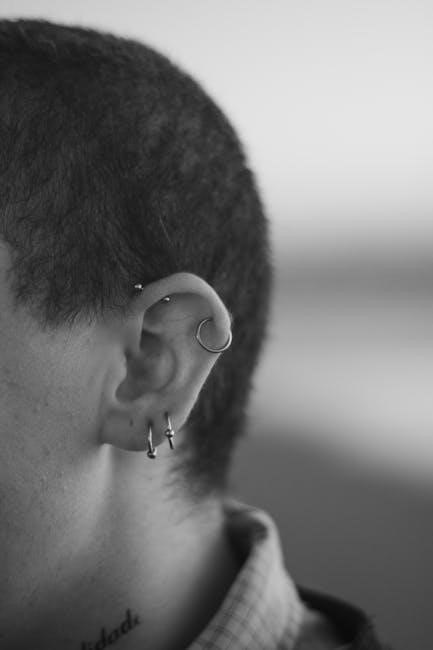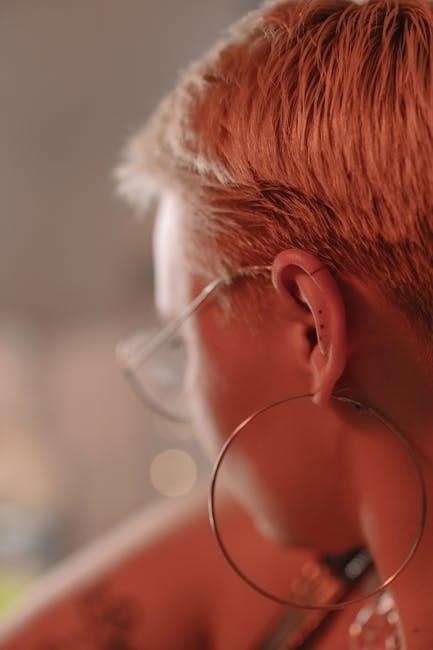Ear piercings are a timeless form of self-expression, evolving from cultural rituals to modern fashion statements. They offer versatility, catering to diverse styles and preferences, making them a popular choice for personal identity and creative expression.
Overview of Ear Piercing History and Popularity
Ear piercings have a rich history dating back thousands of years, with evidence of their existence in ancient civilizations such as Egypt, Minoan, and African cultures. Initially, piercings held spiritual, cultural, or symbolic meanings, often signifying status, spirituality, or rites of passage. In many indigenous communities, ear piercings were a marker of identity and heritage. Over time, their popularity evolved, with fluctuations in acceptance and style. By the 20th century, ear piercings became a mainstream fashion statement, particularly in the 1960s and 1970s, as part of countercultural movements. Today, they are a global phenomenon, embraced for their aesthetic appeal and ability to express individuality. Their enduring popularity stems from versatility, with countless styles and placements available to suit diverse preferences.
Why Choose Ear Piercings for Self-Expression
Ear piercings are a timeless and versatile form of self-expression, offering countless ways to reflect personal style and identity. They allow individuals to showcase creativity and uniqueness, with options ranging from subtle studs to bold, eye-catching designs. Piercings provide a means to convey personality, whether through minimalist elegance or edgy statement pieces. Their appeal lies in their ability to transform one’s appearance and boost confidence. Unlike temporary fashion trends, piercings offer a permanent yet customizable way to express individuality. For many, they serve as a form of empowerment, allowing people to embrace their authenticity and stand out. With so many styles and placements available, ear piercings have become a popular choice for those seeking a meaningful and artistic way to express themselves.

Types of Ear Piercings
Ear piercings come in various styles, each offering unique aesthetics and personalization. Popular options include lobe, helix, tragus, daith, and industrial piercings, catering to diverse preferences and lifestyles.
Lobe Piercing: Location, Popularity, and Pain Level
The lobe piercing is located in the fleshy, lower part of the earlobe, making it one of the most accessible and popular piercings. Known for its minimal pain, it is often rated as a 3/10 on the pain scale, making it ideal for first-time piercing enthusiasts. Healing typically takes 4-6 weeks, during which simple stud jewelry is recommended. Its popularity stems from its versatility, as it suits all face shapes and personal styles. Many choose lobe piercings for their subtle yet elegant appearance, while others opt for multiple lobe piercings for a more bold look. This piercing is a timeless choice, appealing to both classic and contemporary aesthetics.
Helix Piercing: Characteristics and Aftercare Tips
The helix piercing is located on the upper rim of the ear, offering a sleek and modern aesthetic. It is a cartilage piercing, typically rated 6-7/10 on the pain scale, making it moderately painful. Healing takes 3-6 months, during which proper aftercare is crucial. To maintain healing, use a saline solution for cleaning and avoid tight hairstyles that may irritate the area. It is important to keep the jewelry in place during the healing process to prevent the piercing from closing. Helix piercings are popular for their versatility and stylish appeal, with options for studs, hoops, or captive bead rings. Regularly cleaning and avoiding harsh products will ensure a smooth recovery and a beautiful result.
Tragus Piercing: Unique Placement and Jewelry Options
The tragus piercing is situated on the small cartilage flap above the ear canal, offering a subtle yet distinctive look. Its unique placement makes it a popular choice for those seeking a stylish, understated piercing. Jewelry options include small studs, delicate hoops, and captive bead rings, which complement the tragus’s compact location. This piercing is ideal for individuals who prefer a low-key aesthetic while still expressing personal style. The tragus’s visibility can be adjusted based on jewelry choice, allowing for versatility in appearance. With proper care, this piercing can enhance one’s overall look, making it a favorite among those exploring ear piercing options.
Daith Piercing: Strategic Location and Benefits
The daith piercing is located in the innermost fold of the ear cartilage, where the cartilage meets the ear canal. This strategic placement makes it a unique and visually striking option. Known for its potential benefits, such as alleviating migraine symptoms for some individuals, the daith piercing has gained popularity beyond its aesthetic appeal. Its location in the ear’s cartilage allows for a variety of jewelry styles, including rings and studs, which can enhance its distinctive look. While not scientifically proven to cure migraines, anecdotal evidence suggests it may provide relief for some. The daith piercing is a compelling choice for those seeking a piercing with both artistic and wellness-related significance.

Industrial Piercing: Procedure and Jewelry Styles
The industrial piercing involves creating two separate holes in the upper part of the ear, connected by a single piece of jewelry, typically a straight barbell. This piercing is considered more complex due to its double perforation and requires a skilled piercer to ensure proper alignment and placement. The procedure involves piercing both points and immediately inserting the barbell to maintain accuracy. Jewelry options include straight or curved barbells, with variations in length and decoration. Industrial piercings allow for creative customization, such as adding beads or threaded ends. While the standard barbell is most common, some opt for alternative styles like chain or huggie designs. This piercing is favored for its edgy, avant-garde aesthetic, making it a popular choice for those seeking a bold statement.

Jewelry Options for Ear Piercings
Choose hypoallergenic materials like titanium, surgical steel, or 14k gold for comfort and safety. Popular styles include studs, hoops, and captive bead rings, offering versatility for personal expression.
Best Materials for Piercing Jewelry
Choosing the right material for your piercing jewelry is crucial for comfort and safety. Hypoallergenic options like titanium, surgical stainless steel, and 14k gold are ideal for new piercings. Titanium is lightweight, durable, and nickel-free, making it perfect for sensitive skin. Surgical stainless steel is another excellent choice, offering strength and affordability. For a more luxurious option, 14k gold or sterling silver is recommended, as they are non-reactive and stylish. Avoid low-quality materials like brass or plastic, as they can cause allergic reactions or irritation. Always opt for high-quality, implant-grade materials to ensure proper healing and minimize the risk of complications. Your piercer can help you select the best option for your specific piercing type and personal preferences.
Stylish Choices: Studs, Hoops, and Captive Bead Rings
Studs, hoops, and captive bead rings are popular jewelry options for ear piercings, each offering unique style and versatility. Studs are simple yet elegant, featuring a gemstone or decorative front with a secure back, making them ideal for everyday wear. Hoops, available in various sizes and materials, add a bold, eye-catching look and can be paired with other piercings for a layered effect. Captive bead rings are a sleek choice, with a bead that appears “captured” by the ring, creating a minimalist aesthetic. These styles cater to different preferences, allowing individuals to express their personal taste while complementing their piercing location. Whether you prefer understated elegance or a statement piece, these jewelry options provide endless possibilities for customization and self-expression.

Ear Piercing Aftercare
Ear piercing aftercare is crucial for healing and preventing infections. Keep the area clean with saline solution, avoid tight clothing, and avoid submerging the piercing in water.
Essential Aftercare Practices for Healing
Proper aftercare is vital for the healing process of ear piercings. Clean the area daily with a saline solution to prevent infections and promote healing. Avoid submerging the piercing in water, such as in baths or swimming pools, until fully healed. Keep the piercing dry and avoid tight clothing that may irritate the area. Refrain from touching the piercing unnecessarily, as this can introduce bacteria. Avoid playing with or rotating the jewelry excessively, as this can cause irritation and delay healing. Monitor for signs of infection, such as redness, swelling, or discharge, and seek professional advice if they persist. Adhere to your piercer’s recommendations for jewelry changes and aftercare products to ensure a smooth recovery.
Common Mistakes to Avoid During Recovery
Avoid using harsh chemicals, such as hydrogen peroxide or alcohol, as they can irritate the piercing and slow healing. Refrain from submerging the piercing in water, such as in pools or hot tubs, until it is fully healed. Over-handling the jewelry can introduce bacteria and cause irritation. Tight or restrictive clothing that rubs against the piercing should be avoided. Neglecting to clean the piercing regularly or using unclean solutions can lead to infections. Ignoring signs of infection, such as prolonged redness or swelling, can worsen the situation. Avoid changing jewelry too early, as this can disrupt the healing process. Stick to hypoallergenic materials and follow your piercer’s advice to ensure proper recovery.

Pain Levels and Tips
Pain levels vary by piercing type, with lobe piercings being the least painful (3/10) and cartilage piercings like helix or tragus rated higher (6-7/10). To minimize discomfort, use numbing cream, stay relaxed, and choose an experienced piercer. Proper breathing techniques can also help reduce anxiety and pain during the process.
Understanding Pain by Piercing Type
Pain levels vary significantly depending on the piercing location and individual tolerance. Lobe piercings are typically the least painful, rated around 3/10, while cartilage piercings like helix or tragus are more discomforting, often rated 6-7/10. Industrial piercings, involving two holes connected by jewelry, tend to be more painful due to the complexity of the procedure. Numbing creams, such as lidocaine-based products, can help reduce discomfort. Breathing techniques and staying relaxed also play a role in managing pain. It’s important to note that pain is subjective, and what may be tolerable for one person could be more challenging for another. Choosing an experienced piercer and following proper aftercare can also contribute to a smoother experience.
How to Minimize Discomfort During Piercing
To minimize discomfort during an ear piercing, consider using numbing creams containing lidocaine to numb the skin beforehand. Practice deep breathing exercises to stay calm and relaxed, as tension can exacerbate pain. Choosing an experienced piercer ensures a quick and precise procedure, reducing discomfort. Stay hydrated and eat before the piercing to maintain physical stability and prevent lightheadedness. Opt for a clean and calm environment to reduce anxiety. While these methods can enhance comfort, always follow professional advice and ensure the piercer uses high-quality, hypoallergenic jewelry to promote smooth healing. Remember, individual experiences vary, so personal preparation and a positive mindset are key to a comfortable piercing experience.
Healing Timelines
Ear piercings heal at varying rates, with lobe piercings taking 4-6 weeks and cartilage piercings requiring 3-6 months or longer. Proper aftercare ensures timely healing.

Average Healing Times for Different Piercings
Healing times for ear piercings vary depending on the location and individual factors. Lobe piercings typically heal within 4-6 weeks, while cartilage piercings, such as helix or tragus, may take 3-6 months.
More complex piercings like the shell or conch often require 6-12 months to fully heal. Proper aftercare significantly influences healing speed, with clean, gentle care promoting faster recovery.
It’s important to avoid tight jewelry or harsh products that could delay the process. Each person’s healing timeline may vary slightly, but following professional advice ensures optimal results.
